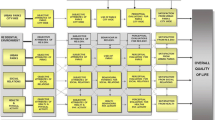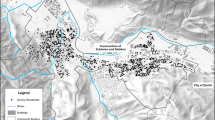Abstract
The subject of urban quality of life and the promotion of its concept in particular, has always been the central focus of urban designers. This term is a multi-conceptual and dimensions. However most of the scholars have agreed that the concept consisted from two main dimensions; objective and subjective which these two approaches are used for its measuring. One of the important goals of urban designers is to create urban environment that all citizens have easy access to urban services, as accessibility reflects the quality of an urban environment. The present research intends to measure the public space accessibility by using objective approach in first and then by using the subjective approach for measuring in the study area to compare the results. The results revealed that there are considerable differences between objective and subjective measuring of urban quality of life in a urban space, therefore urban designers can not rely only on the results of objective measuring to understand such spaces for planning, if so, their attitudes towards urban spaces could not be an appropriate guide for explaining the quality of life for urban residents.



Similar content being viewed by others
References
Alexander, C. (1970). The timeless way of building. New York: Oxford University Press.
Arefi, M., & Meyers, W. R. (2003). What is public about public space: The case of Visakhapatnam. India. Cities, 20(5), 331–339.
Audirac, I. (2002). Information technology and urban form. Journal of Planning Literature, 17, 212–226.
Bertaud, A. (2003). Tehran spatial structure: Constraints and opportunities for future development. Tehran: Ministry of Housing and Urban Development.
Calthorpe, P. (1993). The next American metropolis. New York: Princeton Architectural Press.
Carmona, M., Heath, T., Oc, T., & Tiesdell, S. (2003). Public places: Urban spaces. Oxford: Architectural Press.
Castells, M. (2000). The rise of the network society, the information age: Economy, society and culture. Oxford, UK: Blackwell.
CNU. (2000). Charter of the new urbanism. Congress for the new urbanism. New York: McGraw-Hill.
Couclelis, H., & Arthur, G. (2000). Conceptualizing and measuring accessibility in physical and virtual spaces. In D. Janelle & D. Hodge (Eds.), Information, place, and cyberspace. New York: Springer.
Cowan, R. (2005). The dictionary of urbanism. Wiltshire: Streetwise Press.
Cromley, E. K., & McLafferty, S. L. (2002). GIS and public health. New York: The Guilford Press.
Das, D. (2007). Urban quality of life: A case study of Guwahati. Social Indicators Research, 88, 297–310. doi:10.1007/s11205-007-9191-6.
Davies, B. P. (1968). Social needs and resources in local services. London: Michael Joseph.
Day, K., Anderson, C., Powe, M., McMillan, T., & Winn, D. (2007). Remaking minnie street: The impacts of urban revitalization on crime and pedestrian safety. Journal of Planning Education and Research, 26, 315–331.
Dissart, J. C., & Deller, S. C. (2000). Quality of life in the planning literature. Journal of Planning Literature, 15(1), 135–161.
Doi, K., Kii, M., & Nakanishi, H. (2007). An integrated evaluation method of accessibility, quality of life, and social interaction. Environment and Planning B: Planning and Design, 35, 1098–1116. doi:10.1068/b3315t.
Duany, A., & Platter-Zyberck, E. (1991). Towns and town-making principles. New York: Rizolli Pub.
Erkip, F. (1997). The distribution of urban public services: The case of parks and recreational services in Ankara. Cities, 14(6), 353–361.
Evans, D. R. (1994). Enhancing quality of life in the population at large. Social Indicators Research, 33, 47–88.
Francis, M. (1989). Control as a dimension of public space quality. In I. Altman & E. H. Zube (Eds.), Human behavior and environment: Advances in theory and research. New York: Plenum Press.
Geurs, K. T., & Ritsema van Eck, J. R. (2003). Evaluation of accessibility impacts of land-use scenarios: The implications of job competition, land-use, and infrastructure developments for the Netherlands. Environment and Planning B: Planning and Design, 30, 69–87.
Glazer, N., & Lilla, M. (1987). The public face of architecture. New York: Free Press.
Goodmann, W. (1968). Principles and practice of urban planning. Washington: International City Manager’s Association.
Gould, M. (1997). Modelling third wave (virtual) accessibility. In: Paper presented at seminar in planning support systems, Cambridge, MA, USA.
Graham, S., & Marvin, S. (1996). Telecommunications and the city, electronic spaces, urban places. New York: Routledge.
Graham, S., & Marvin, S. (1999). Planning cybercities? Integrating telecommunications into urban planning? Town Planning Review, 70, 79–114.
Grayson, L., & Young, K. (1994). Quality of life in cities: An overview and guide to literature. London: The British Library.
Gregory, D. (1986). Accessibility. In R. J. Johnston, D. Gregory, & D. R. Stoddart (Eds.), The dictionary of human geography (2nd ed.). Oxford, England: Blackwell.
Hanson, S. (2000). Reconceptualising accessibility. In D. G. Janelle & D. C. Hodge (Eds.), Information, space and cyber space, issues in accessibility (pp. 267–276). Berlin: Springer.
Hare, T. S., & Barcus, H. L. (2007). Geographical accessibility and Kentucky’s heart-related hospital services. Applied Geography, 27, 181–205.
Hatry, H. P., & Dunn, D. R. (1971). Measuring the effectiveness of local government services, recreation. Washington, DC: The Urban Institute.
Hay, A. M. (1995). Concepts of equity, fairness and justice in geographical studies. Transactions of the Institute of British Geographers, 20, 500–508.
Janelle, D. G., & Hodge, D. C. (2000). Information, space and cyber space and accessibility. In D. G. Janelle & D. C. Hodge (Eds.), Information, space and cyber Space, issues in accessibility. Berlin: Springer.
Johnston, R. J., Gregory, D., Pratt, G., & Watts, M. (2000). The dictionary of human geography. Oxford: Blackwell Publishing.
Johnston, P., & Nolan, J. (2002). E-work 2002, status report on new ways to work in the information society. Brussels: European Commission.
Jones, K., & Kirby, A. (1982). Provision and well being: An agenda for public resources research. Environment and Planning A, 14(4), 297–310.
Kallus, R. (2001). From abstract to concrete: Subjective reading of urban space. Journal of Urban Design, 6(2), 129–150.
Katz, P. (1994). The new urbanism: Toward an architecture of community. New York: McGraw Hill.
Kenyon, S., Lyons, G., & Rafferty, J. (2002). Transport and social exclusion investigating the possibility of promoting inclusion through virtual mobility. Journal of Transport Geography, 10, 207–219.
Kirby, A., Knox, P., & Pinch, S. (1983). Developments in public provision and urban politics: An overview and agenda. Area, 15(4), 295–300.
Knox, P. (1987). Urban social geography: An introduction (2nd ed.). England: Longman Scientific & Technical.
Krier, L. (1984). Houses, palaces and cities. New York: St. Martin’s Press.
Langdon, P. (1994). A better place to live: Reshaping the American suburb. Amherst, MA: University of Massachusetts Press.
Lefebvre, H. (1991). The production of space. Oxford: Basil Blackwell. Trans. D. Nicholson-Smith.
Liska, A. E., Sanchirico, A., & Reed, M. D. (1988). Fear of crime and constrained behavior specifying and estimating a reciprocal effects model. Social Forces, 66(3), 827–837.
Lynch, K. (1981). Good city form. Cambridge, MA: MIT Press.
Madanipour, A. (1992). Design of urban space: An inquiry into a socio-spatial process. West Sussex: Wiley.
Martens, M., Wilmink, I., Korver, W., Heijma, A., van Katwijk, R., & Harrell, L. (1999). The mobility impact of the electronic highway. Delft: TNO.
Massam, B. (1975). Location and space in social administration. Halsted, New York: Edward Arnold.
Massam, B. H. (2002). Quality of life: Public planning and private living. Progress in Planning, 58, 141–227.
McCrea, R., Shyy, T., & Stimson, R. (2006). What is the strength of the link between objective and subjective indicators of urban quality of life? Applied Research in Quality of Life, 1, 79–96.
Mitchell, D. (1995). The end of public space? People’s park, definitions of the public, and democracy. Annuals of the Association of American Geographers, 85, 33–108.
Morris, J. M., Dumble, P. L., & Wigan, M. R. (1979). Accessibility indicators for transportation planning. Transportation Research A, 13, 91–109.
Moudon, A. V. (1992). A Catholic approach to organizing what urban designers should know. Journal of Planning Literature, 6(4), 331–349.
Muhammad, S., Jong, T. D., & Ottens, H. F. L. (2008). Job accessibility under the influence of information and communication technologies, in the Netherlands. Journal of Transport Geography, 16, 203–216.
OEI. Organization of Environment of Iran. (2006). Annual reports of the capital pollution, Tehran, Iran.
Ogryczak, W. (2000). Inequality measures and equitable approach to location problems. European Journal of Operational Research, 122, 374–391.
Pain, R. (2000). Place, social relations and the fear of crime: A review. Progress in Human Geography., 24, 365–387.
Pain, R., MacFarlane, R., Turner, K., & Gill, S. (2006). When, where, if, and but: Qualifying GIS and the effect of streetlighting on crime and fear. Environment and Planning A, 38, 2055–2074.
Pasaogullari, N., & Doratli, N. (2004). Measuring accessibility and utilization of public spaces in Famagusta. Cities, 21(3), 225–232.
Pinch, S. (1984). Inequality in pre-school provision: A geographical perspective. In A. Kirby, P. Knox, & S. Pinch (Eds.), Public service provision and urban development (pp. 231–282). London: Croom Helm.
Pinch, S. (1985). Cities and services. London: Routledge & Kegan Paul.
Rich, R. C. (1979). Neglected issues in the study of urban service distribution: A research agenda. Urban Studies, 16, 143–156.
Scott, L. (2000). Evaluating intra-metropolitan accessibility in the information age: Operational issues, objectives and implementation. In D. Janelle & D. Hodge (Eds.), Information, place, and cyberspace. New York: Springer.
Sirgy, M. J., & Cornwell, T. (2002). How neighborhood features affect quality of life. Social Indicators Research, 59(1), 79–114.
Smith, D. M. (1994). Geography and social justice. Colchester, VT: Blackwell.
Sorkin, M. (1992). Variations on a theme park: The New American City and the end of public space. New York: Hill and Wang.
Szalai, A. (1980). The meaning of comparative research on the quality of life. In A. Szalai & F. M. Andrews (Eds.), The quality of life: Comparative studies. London: Sage.
Talen, E. (1998). Visualizing fairness: Equity maps for planners. Journal of the American Planning Association, 64(1), 22–38.
Talen, E. (2000). Measuring the public realm: A preliminary assessment of the link between public space and sense of community. Journal of Architectural and Planning Research, 17(4), 344–359.
Talen, E. (2002). Pedestrian access as a measure of urban quality. Planning Practice and Research, 17(3), 257–278.
Talen, E. (2003). Neighborhoods as service providers: A methodology for evaluating pedestrian access. Environment and Planning B: Planning and Design, 30, 181–200.
Talen, E., & Anselin, L. (1998). Assessing spatial equity: An evaluation of measures of accessibility to public playgrounds. Environment and Planning A, 30, 595–613.
Tibbalds, F. (1992). Making people friendly towns: Improving the public environments in towns and cities. Harlow, Essex: Longman Press.
Tsou, K. W., Hung, Y. T., & Chang, Y. L. (2005). An accessibility-based integrated measure of relative spatial equity in urban public facilities. Cities, 22(6), 361–424.
Vandenbulcke, G., Steenberghen, T., & Thomas, I. (2008). Mapping accessibility in Belgium: A tool for land-use and transport planning? Journal of Transport Geography. doi:10.1016/j.jtrangeo.2008.04.008.
Vrij, A., & Winkel, F. W. (1991). Characteristics of the built environment and fear of crime: A research note on interventions in unsafe locations. Deviant Behaviour, 12, 203–215.
Walker, B. (1981). Welfare economics and urban problems. London: Hutchinson.
Warr, M. (1990). Dangerous situations: Social context and fear of victimization. Social Forces, 68, 891–907.
White, A. N. (1979). Accessibility and public facility location. Economic Geography, 55(1), 18–35.
White, M., Kasl, S. V., Zahner, G. E. P., & Will, J. C. (1987). Perceived crime in the neighborhood and mental health of women and children. Environment and Behavior, 19(5), 588–613.
Whyte, H. W. (2000). How to turn a place around. Projects for Public Space Inc.
Worpole, K. (1992). Towns for people: Transforming urban life. Buckingham: Buckingham University Press.
Author information
Authors and Affiliations
Corresponding author
Rights and permissions
About this article
Cite this article
Lotfi, S., Koohsari, M.J. Analyzing Accessibility Dimension of Urban Quality of Life: Where Urban Designers Face Duality Between Subjective and Objective Reading of Place. Soc Indic Res 94, 417–435 (2009). https://doi.org/10.1007/s11205-009-9438-5
Received:
Accepted:
Published:
Issue Date:
DOI: https://doi.org/10.1007/s11205-009-9438-5




